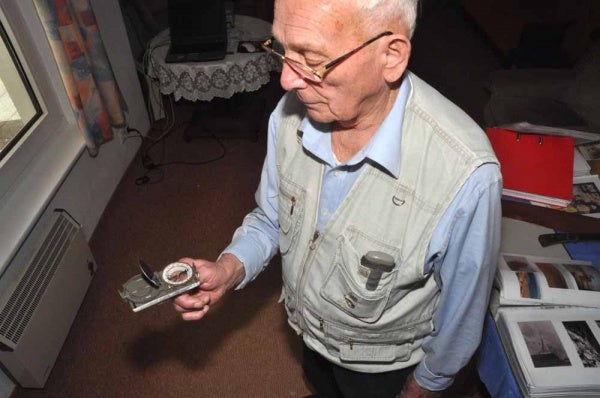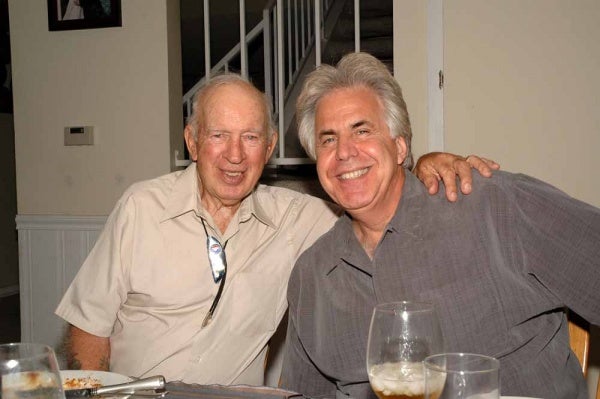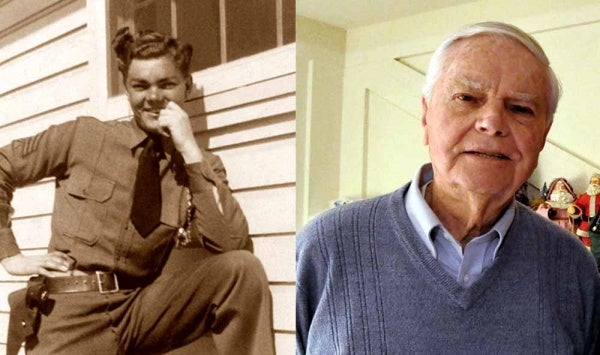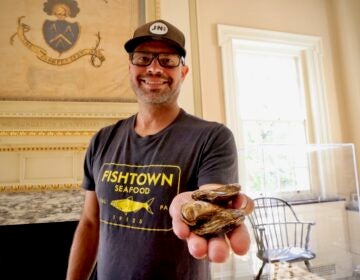East Falls resident works to preserve WWII veterans’ stories
With the dwindling number of World War II veterans still alive, one man is doing his part to preserve the stories of those who have been dubbed, “The Greatest Generation.”
For the past six years, East Falls resident Michael Fraticelli has been working on an independent, educational, non-profit film called Survivors’ Stories: North Africa 1942-43.
“It all started when I found a few letters written by my dad,” said Fraticelli. “It was like he was trying to keep a journal.
“ Michael’s father, Anthony Fraticelli served in the U.S. Coast Guard during World War II. In fact, Anthony tried enlisting weeks before the Pearl Harbor attack but was initially turned down. The letters found by his son talked about his experience on the USS Thomas Stone. The USS Stone was the only ship to be torpedoed in the Eastern Task Force during Operation Torch and the invasion of North Africa.
Seven years ago, Michael went to a 39th Infantry, 9th Division reunion in Lancaster that he had heard about from an area resident who served in that division.
“I went to see if someone knew my dad,” said Fraticelli.
Fraticelli estimates that around 100 people were at that reunion. Only a handful had been aboard the USS Thomas Stone. Out of that handful, only veteran Gene Johnson claimed to vaguely remember Michael’s father.
Slowly, the idea to make a film began to form with a purpose: to preserve the stories that these men had to tell about little-known facts that contribute to a well-known historical event. What started as a project dealing with four veterans became a behemoth encompassing more than 30 veterans from both sides of the battle lines including Gen. Rommel’s personal driver.
“This project should be viewed as our last chance to see and hear from these men,” said Fraticelli. “They represent the oldest veterans from the North Africa campaign.”
Telling the untold stories
Operation Torch was the first Allied (Anglo-American) invasion of the Mediterranean. It was a herculean task for British Prime Minister Winston Churchill to convince Allied leaders to use a peripheral approach in defeating the Axis Powers. Instead of striking at the heavily defended heart of Nazi Germany, the Allies grinded down the Axis and eventually took control of the Med, eventually invading Sicily and Italy.
The invasion started in Northwest Africa with Operation Torch. During the invasion, the USS Thomas Stone was torpedoed and disabled. A decision was made to launch 24 tiny landing craft still 160 miles away from Algiers. The journey was treacherous, and nearly led to their demise. Those 750 troops were rescued by HMS Spey, and were delivered safely to Algiers. The USS Stone would face yet another crisis when its tow line broke, and the ship became lodged in the sand in the Algiers harbor.
It was during this time that Coxswain Gene Johnson and Coast Guardsman Anthony Fraticelli, along with their comrades repelled repeated air attacks from Luftwaffe JU-88’s. According to Michael Fraticelli, Johnson remembered that as he leaned over the side of the ship “he saw a tremendous crater in the sand and a huge hole in the hull of the ship. A bomb had passed unexploded directly through the ship lodging itself in the sand.”
Although Anthony Fraticelli and Gene Johnson returned to the states sometime in 1943, it was still the beginning for Sabato, Barnett and Faulkner.
The battle of El Guettar is best summed up by the 9th Infantry Division commander, Maj. Gen. Manton S. Eddy.
“The 9th Infantry Division had entered its first engagement with the enemy, the Battle of El Guettar, greatly handicapped in not having had time for sufficient reconnaissance and in not having all of the units of the division under division control.”
Of course, the truth is not so nearly black and white. The truth still haunts the veterans in living graphic color some days.
German Field Marshall Erwin Rommel’s Afrika Korps had the advantage being dug into a strong defensive position. American forces thought they were smoking out a tired Italian division and attacked at night with weapons unloaded and bayonets fixed.
“It was like taking a bunch of neighborhood kids and having them play against the Dallas Cowboys,” said veteran Joe Barnett, in interview footage.
Gen. Eddy went on with his summary, “Going through this battle, however, they learned lesson after lesson, learning the hard way.”
The logistics
Fraticelli has done massive amounts of research including many trips to the National Archives, paying for hundreds of hi-res photos and vintage film copies. Fraticelli also interviewed the veterans, usually over the phone. Filming and preparation has taken a long amount of time since Fraticelli has been self-financing the project.
“The accepted doctrine regarding financing is ‘never use your own money’,” said Fraticelli. “Had I followed this path there would never be a project, the veterans would have vanished.”
Over time, Fraticelli had to settle on a few select staff but took on much of the tasks himself. Fraticelli mentioned two people who have stayed with him from the beginning: Line Producer Leilani Goode and Prop Master Kurt Eberling Jr. Fraticelli who recently wrapped filming of scenes recreating many events such as the Battle of El Guettar, the USS Stone being put in harm’s way and other scenes. These recreations used a mix of actors and re-enactors.
“However, don’t expect to see the dramatic acting, gore or special effects of ‘Saving Private Ryan’,” said Fraticelli.
A labor of love
The project, while a labor of love, has also exacted a financial and emotional toll. After retiring from the City of Philadelphia, Fraticelli had to take up a part-time job to finance this pet project after his own savings were spent. Fraticelli also parted ways with a music band that he had been performing with for many years after a spokesman expressed, according to Fraticelli, ‘extremely negative criticism debating the need or worth for such a project.’
“I always distance myself from such negativity or lack of understanding,” said Fraticelli.
But the emotional cost also comes from another source; Father Time. According to Fraticelli, out of the 35 people he has interviewed; half have died. Fraticelli has built relationships with many of these veterans; practically becoming family, only having to face their eventual passing.
“It’s almost ridiculous to tackle something like this alone,” said Fraticelli “Nonetheless, I stand resolute in this commitment; this is my legacy to these men. I will see it through.”
For more about Survivors’ Stories, log on to www.ww2survivorstories.com.
WHYY is your source for fact-based, in-depth journalism and information. As a nonprofit organization, we rely on financial support from readers like you. Please give today.








